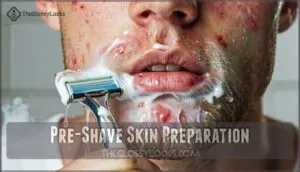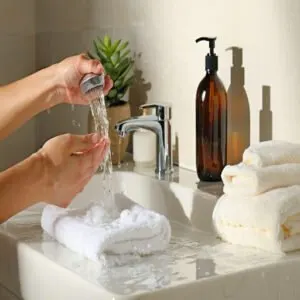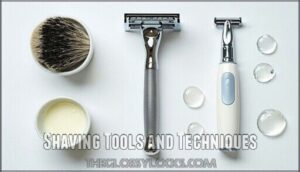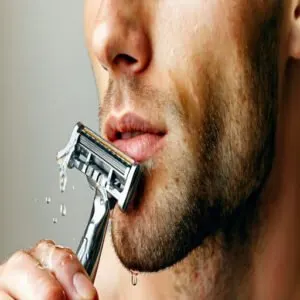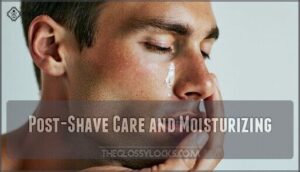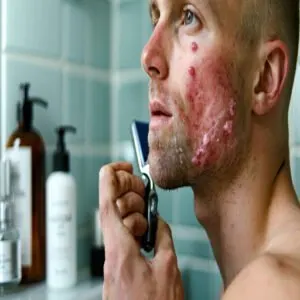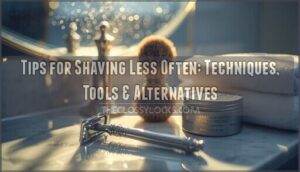This site is supported by our readers. We may earn a commission, at no cost to you, if you purchase through links.
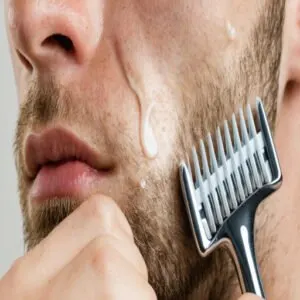
Start by washing your face with a gentle cleanser to remove dirt and oil without irritating your skin.
Exfoliate lightly to clear dead skin and open up those pores, but don’t overdo it!
Pick a gel-based, alcohol-free shaving cream to keep things smooth and hydrated.
Use a fresh, sharp razor and shave with soft, short strokes—go with the grain to avoid bumps.
After shaving, apply a water-based, non-comedogenic moisturizer to keep your skin calm and balanced.
Avoid shaving over painful acne spots, and consider an electric razor if irritation’s a problem.
Keep learning—your skin deserves it!
Table Of Contents
- Key Takeaways
- Pre-Shave Skin Preparation
- Shaving Tools and Techniques
- Minimizing Razor Bumps and Acne
- Post-Shave Care and Moisturizing
- Shaving With Acne-Prone Skin
- Frequently Asked Questions (FAQs)
- How do you shave with oily skin?
- How to avoid getting acne from shaving?
- Is face shaving good for oily skin?
- Why does my acne get worse when I shave?
- How often should you shave with oily skin?
- Can diet affect shaving outcomes and acne?
- Are natural remedies effective for shaving irritation?
- Whats the role of sunscreen in shaving routines?
- How does stress impact skin and shaving results?
- Conclusion
Key Takeaways
- Use a gentle cleanser and exfoliate lightly before shaving to remove dirt, oil, and dead skin, prepping your pores for a smooth experience.
- Pick a gel-based shaving cream that is alcohol-free, non-comedogenic to keep your skin hydrated without clogging pores or causing irritation.
- Always shave with the grain using a fresh, sharp razor and use light, short strokes to avoid razor bumps and irritation.
- Apply a water-based moisturizer after shaving to calm your skin, prevent breakouts, and control excess oil.
Pre-Shave Skin Preparation
Getting your skin ready before shaving is key, especially if it’s oily or acne-prone. A proper cleanse and using the right products can help reduce irritation and prevent breakouts.
Choosing The Right Shaving Cream
Finding the right shaving cream for oily skin matters.
Look for non-comedogenic products that won’t clog your pores. For acne-prone skin, proper shaving cream selection is essential, so consider these best shaving cream tips.
Here’s what to check:
- Pick alcohol-free creams to prevent irritation.
- Use gel-based foams for better hydration.
- Avoid heavy oils or fats—no shiny aftermath!
- Prefer anti-inflammatory ingredients for soothing.
- Focus on cleansing creams that lift dirt and oil pre-shave.
Stay smooth!
Pre-Shave Cleansing and Exfoliation
Before you shave, start with gentle cleansing to remove dirt and extra oil—this is key for skin purification.
Follow up with an exfoliating cleanser to clear dead skin and prep your pores.
Facial exfoliants work wonders for pore minimization and oil control methods.
Remember, oily skin shaving goes smoother when you exfoliate before shaving, helping avoid irritation.
Prepping for Shaving With Acne
Before tackling acne-prone skin, prepping matters.
Start with a gentle cleanser and warm water to clear dirt and oil.
Follow up with light exfoliation to unclog pores—this is Acne Prevention 101.
Use a warm washcloth to soften your skin and hair.
Avoid shaving over any deep, painful acne.
Apply a non-irritating shaving cream designed for oily skin.
Shave Preparation? Check.
No shortcuts here!
For more detailed guidance, consult this informative article on shaving with active acne.
Importance of Gentle Cleansers
Using a gentle cleanser is key to a solid oily skin shaving routine.
It clears away dirt and oil without stripping your skin, keeping it balanced for shaving.
Gentle exfoliation through facial cleansing preps your skin and prevents irritation.
For further guidance, explore this helpful resource on gentle cleansers for sensitive skin.
Look for noncomedogenic products designed for sensitive skin, and add this step to your daily skincare routine for happier, healthier shaves, using a routine that includes a daily skincare approach.
Shaving Tools and Techniques
The right tools and techniques make shaving with oily, acne-prone skin stress-free. Here’s how to nail it:
- Razor Blade Sharpening: Always use a fresh, sharp blade—it gives smoother results and avoids irritating skin. If you prefer double-edge (DE) razors, they’re great for oily skin and easy to clean.
- Shaving Strokes and Blade Angles: Go slow with light, short strokes, and let the blade glide naturally at an angle. This reduces tugging and leaves fewer bumps.
- Electric Shavers for Safety Precautions: Electric shavers are ideal for oily skin—they minimize razor burn and work best on dry faces. Keep it steady, don’t press hard, and clean the shaver after every use.
For a consistently smooth shave, explore these pre-shave routine tips.
A little prep and technique can transform shaving into a smooth, skin-friendly routine!
Minimizing Razor Bumps and Acne
Using the right razor and technique can help you avoid razor bumps and prevent acne flare-ups.
Stick to sharp blades, gentle strokes, and tools designed for sensitive, oily skin to keep irritation in check.
Utilizing a Sharp Razor Blade
A dull blade’s your worst enemy—oily skin reacts fast to irritation.
A sharp blade glides smoothly, cutting hair without tugging or scraping.
Swap blades every 5-7 shaves; dull edges can trigger nicks and bumps.
Proper razor blade maintenance keeps things clean and safe, especially for acne-prone shaving.
Sharp edge importance isn’t hype—it’s key for smooth, irritation-free shaving.
Shaving Tools and Technique
A smooth shave starts with the right approach.
Remember these tips:
- Use gentle shaving strokes—don’t press too hard.
- Guarantee razor blade care by replacing dull ones weekly; sharpness is key.
- Electric shavers are perfect for oily skin—less irritation, fewer nicks.
- Start with proper shave preparation, letting shaving cream sit before gliding your blade.
For detailed guidance, explore these effective shaving techniques to minimize bumps, and remember that a smooth shave is the ultimate goal of following these steps, using the right tools, such as a sharp razor.
Choosing The Right Tools
Let’s talk tools – picking the right ones can make or break your shaving game with oily skin.
A fresh, clean blade is your best friend, so grab either a single blade or a triple-blade razor instead of those multi-blade monsters.
For those seeking the perfect blade, specialized best razor oily skin products are available.
Skip the alcohol-loaded products, and invest in a quality shaving brush to whip up that lather, and opt for a creamy, non-comedogenic shaving cream that won’t clog your pores.
Mastering The Shaving Technique
Mastery of your razor grip can make or break your shaving game.
Hold your blade at a gentle angle while maintaining light skin tension to boost blade efficiency and prevent irritation.
Keep those strokes short and sweet, always moving with your hair’s growth pattern.
Don’t push hard – your razor should glide like butter, especially over acne-prone areas.
Rinse after each pass to dodge razor burn and ingrown hairs.
Post-Shave Care and Moisturizing
You’ll need to give your skin some extra care after shaving since the process can strip away natural moisture and leave your oily skin feeling tight and irritated.
Using the right moisturizer after shaving won’t make your acne worse, but instead will help keep your skin balanced and prevent excess oil production.
Post-Shave Moisturizing and Hydration
Now that you’ve got those razor bumps under control, it’s time for proper hydration.
Your skin loses moisture during shaving, so quick action with the right post-shave care makes all the difference.
Keep your face balanced with a water-based moisturizer that won’t trigger excess oil.
- Gentle, alcohol-free moisturizer calms razor-stressed skin
- Tea tree oil and salicylic acid help prevent breakouts
- Light, matte formulations control excess shine
- Water-based lotions provide balanced hydration
- Natural ingredients soothe and repair your skin
Think of post-shave moisturizing as giving your skin a revitalizing drink after a workout.
Pat your face dry, then apply a light hydrating product that lets your skin breathe.
Importance of Non-Comedogenic Moisturizers
A smart moisturizer choice makes all the difference for your post-shave routine.
Non-comedogenic gel moisturizers work best for acne-prone skin, delivering hydration without clogging pores.
For even better results, consider non-comedogenic hydrating moisturizers specifically formulated for dry skin that’s also prone to breakouts.
Look for powerhouse ingredients like salicylic acid to prevent breakouts while moisturizing, and consider products like Sebamed Clear Face Care Gel and Clinique 100H moisture surge, both proven effective for oily skin maintenance.
Soothing Aftershave Balms
In the context of aftershave balm for acne prone skin, natural ingredients are your best friends.
Choose calming gels with witch hazel and tea tree – these skin soothers effectively fight breakouts while keeping oil in check.
Skip thick creams and reach for lightweight formulas that won’t clog pores.
A good razor relief option should include chamomile and vitamin E for extra healing power.
You can find a selection of suitable aftershave balm acne products online.
Shaving With Acne-Prone Skin
If you’re dealing with acne-prone skin, you’ll need to be extra careful when shaving to avoid irritation and breakouts.
You can still get a close, comfortable shave by using the right tools and techniques that work with your sensitive skin, not against it.
Understanding Acne and Shaving
Acne and shaving can be a bit tricky, but knowing the basics helps.
Acne happens from clogged pores, while razor burn risks like dull blades or wrong technique can worsen it.
To avoid skin irritation and razor burn, follow these steps:
- Choose sharp, clean blades.
- Use non-comedogenic products.
- Shave gently with the grain.
- Avoid deep, inflamed areas.
Preventing Acne and Razor Bumps
To prevent breakouts and razor bumps, cleanse your face first to remove dirt and oil.
Use shaving cream designed for acne-prone skin; it’s all about lubrication.
Always shave with a sharp blade to avoid irritation, and go with the grain, not against it.
Finish with a non-comedogenic moisturizer to protect your skin and keep it breakout-free.
Shaving Techniques for Acne-Prone Skin
Don’t let shaving irritate oily, acne-prone skin.
Keep it simple and gentle:
- Always use a sharp, clean blade—dull razors cause razor burn and irritation.
- Apply a non-comedogenic shave gel to protect your skin and manage hair smoothly.
- Shave with light strokes in the direction of hair growth.
- Skip shaving over painful pimples to avoid worsening breakouts.
Electric Razors and Acne Prevention
Electric razors are your skin’s best buddy if acne’s a hassle.
They’re gentle, reducing nicks, cuts, and irritation, perfect for oily, acne-prone skin.
Use light pressure, start on sensitive spots, and keep it clean for acne prevention.
A quick tip? Pair your routine with gentle exfoliation to prevent razor bumps or ingrown hairs.
| Benefit | Tip |
|---|---|
| Gentle on acne | Use light pressure to avoid irritation. |
| Less irritation | Start shaving sensitive areas first. |
| Cleaner shave, no tugging | Clean the electric razor regularly for razor maintenance. |
| Prevent bumps and acne | Combine with gentle exfoliation and proper skin protection techniques. |
This text highlights the benefits and provides tips for using electric razors, especially for acne-prone skin, emphasizing the importance of gentle care, proper maintenance, and exfoliation.
Frequently Asked Questions (FAQs)
How do you shave with oily skin?
Wash your face with a gentle cleanser to remove oil, then use a shaving cream made for oily skin.
Always use a fresh blade, shave with the grain, and moisturize to avoid irritation.
How to avoid getting acne from shaving?
Think of shaving as walking a tightrope—balance is key.
Prep with a gentle cleanser, use a sharp, clean blade, shave with the grain.
Finish with a non-comedogenic moisturizer to keep acne at bay.
Is face shaving good for oily skin?
Shaving can work for oily skin if you prep properly.
Cleanse and soften your skin first, use a non-comedogenic shaving cream, and glide with a fresh blade.
Skip shaving over active acne to avoid irritation.
Why does my acne get worse when I shave?
It’s like pouring gas on a fire—when you shave, dull blades, harsh products, or improper techniques can irritate your skin, inflame acne, and spread bacteria.
Use sharp razors, gentle products, and shave in the hair’s direction.
How often should you shave with oily skin?
You should shave every two to three days if you’ve got oily skin.
Shaving too often might irritate your skin, but waiting too long can cause clogged pores.
Stick to a routine that feels comfortable.
Can diet affect shaving outcomes and acne?
What you eat can show up on your skin.
Greasy foods, sugary snacks, and dairy might trigger acne, making shaving harder.
Balance it out with fruits, veggies, and water to help your skin stay calm.
Are natural remedies effective for shaving irritation?
When your skin’s yelling “help” after shaving, natural remedies like aloe vera or witch hazel can calm irritation.
They reduce redness, fight bacteria, and soothe discomfort.
Stick with simple, proven options for gentler post-shave care using aloe vera.
Whats the role of sunscreen in shaving routines?
Sunscreen protects your skin from irritation, dark spots, and redness caused by UV rays after shaving.
Pick a non-comedogenic, oil-free option to avoid clogged pores, especially if you’ve got oily or acne-prone skin.
How does stress impact skin and shaving results?
Stress messes with your skin by triggering more oil production and inflammation, making shaving harder.
You’ll notice more acne and irritation, so tackle stress with sleep, hydration, or exercise to keep your skin calm and balanced.
Conclusion
Struggling with shaving your oily, acne-prone skin doesn’t have to be a headache.
By sticking to a gentle pre-shave routine, using a gel-based shaving cream, and opting for a sharp razor with proper technique, you can cut down on bumps and breakouts.
Don’t forget to hydrate with a water-based, non-comedogenic moisturizer after each shave to keep skin calm and healthy.
Follow these shaving tips for oily skin prone to acne, and you’ll see smoother, clearer skin over time.
- https://gillette.com/en-us/shaving-tips/how-to-shave/acne
- https://www.gillette.co.in/en-in/tips-for-shaving/shaving-tips/acne
- https://www.healthline.com/health/acne/shaving-with-acne
- https://www.gillette.co.uk/blog/how-to-shave/acne/
- https://www.mdacne.com/article/how-to-shave-when-you-have-acne-10-dermatologist-tips

